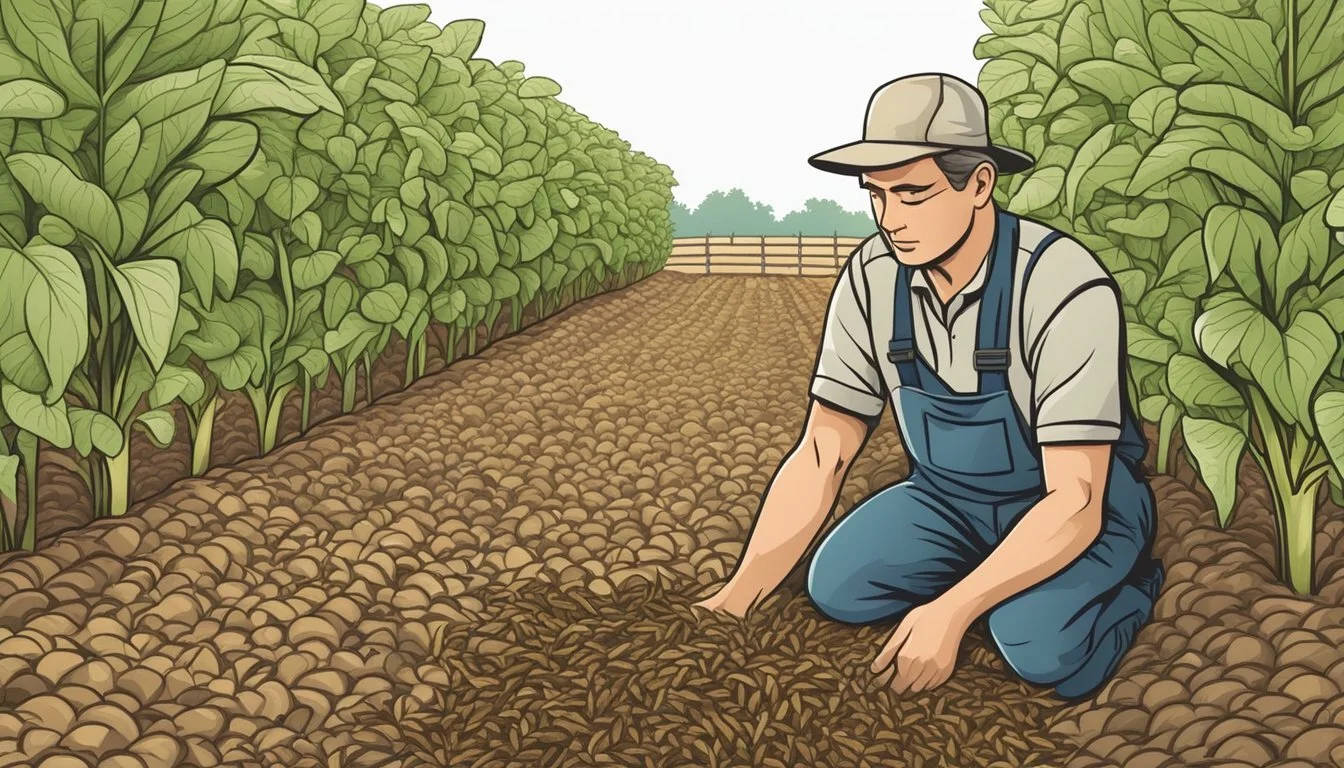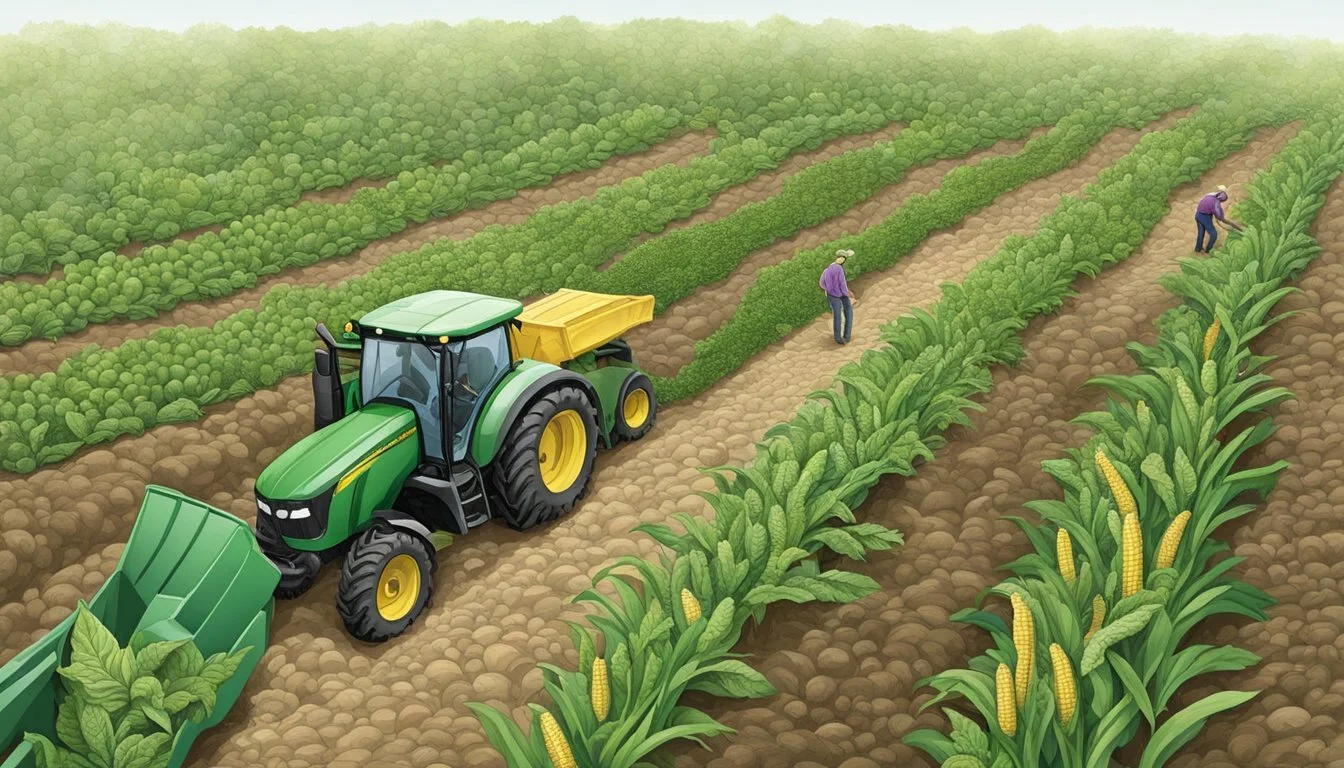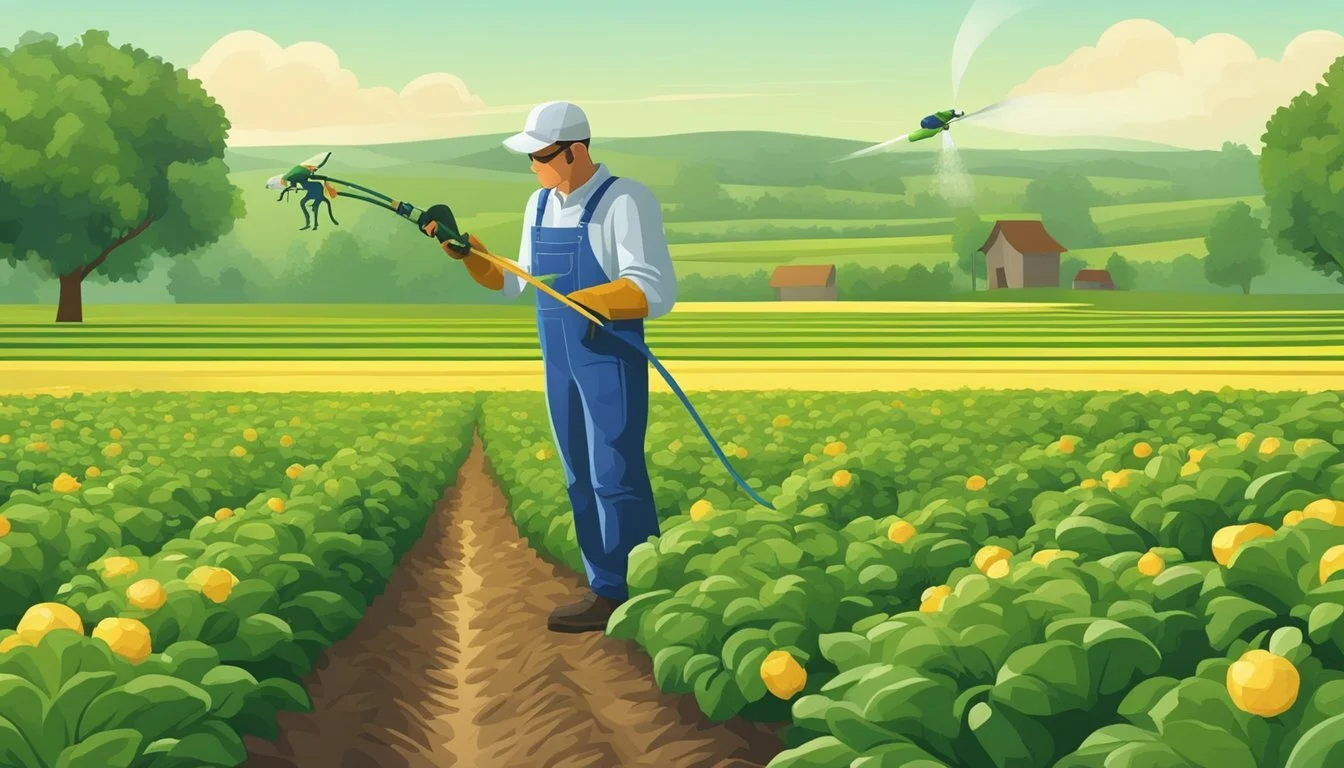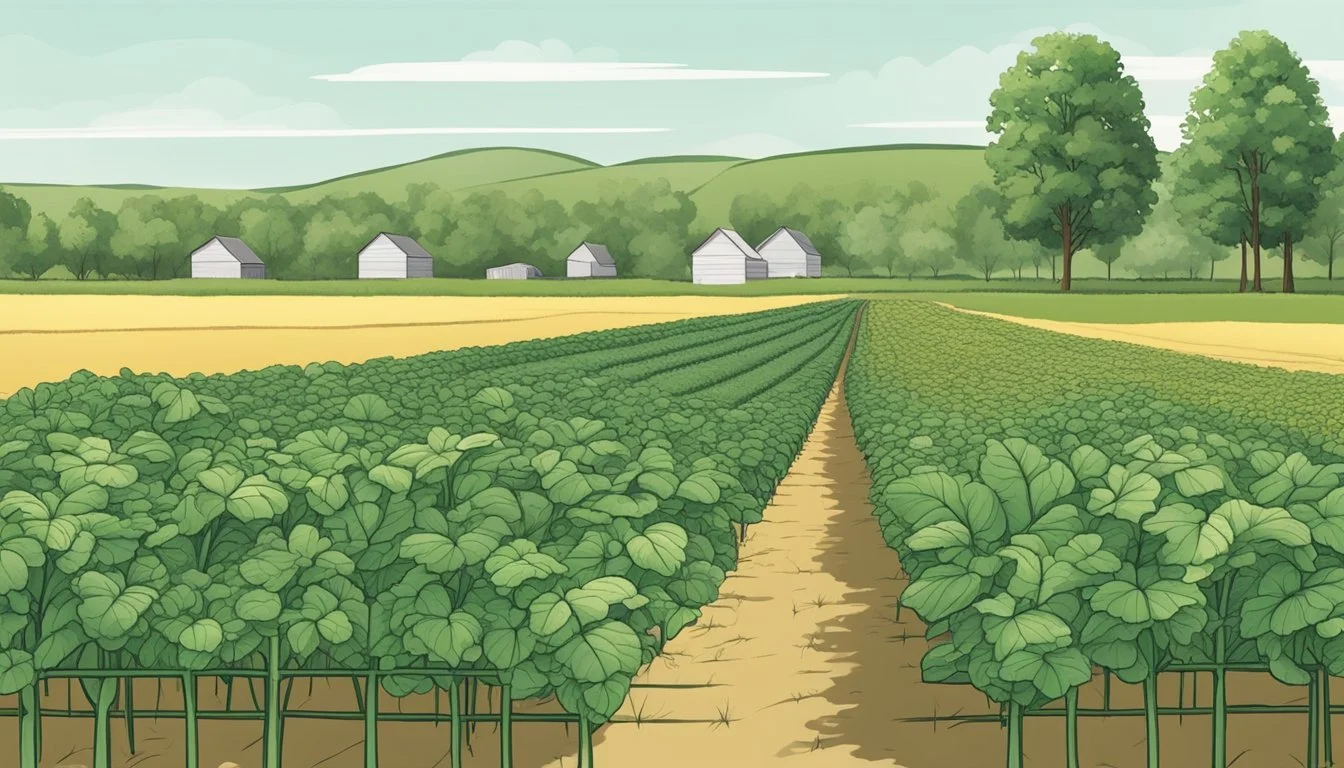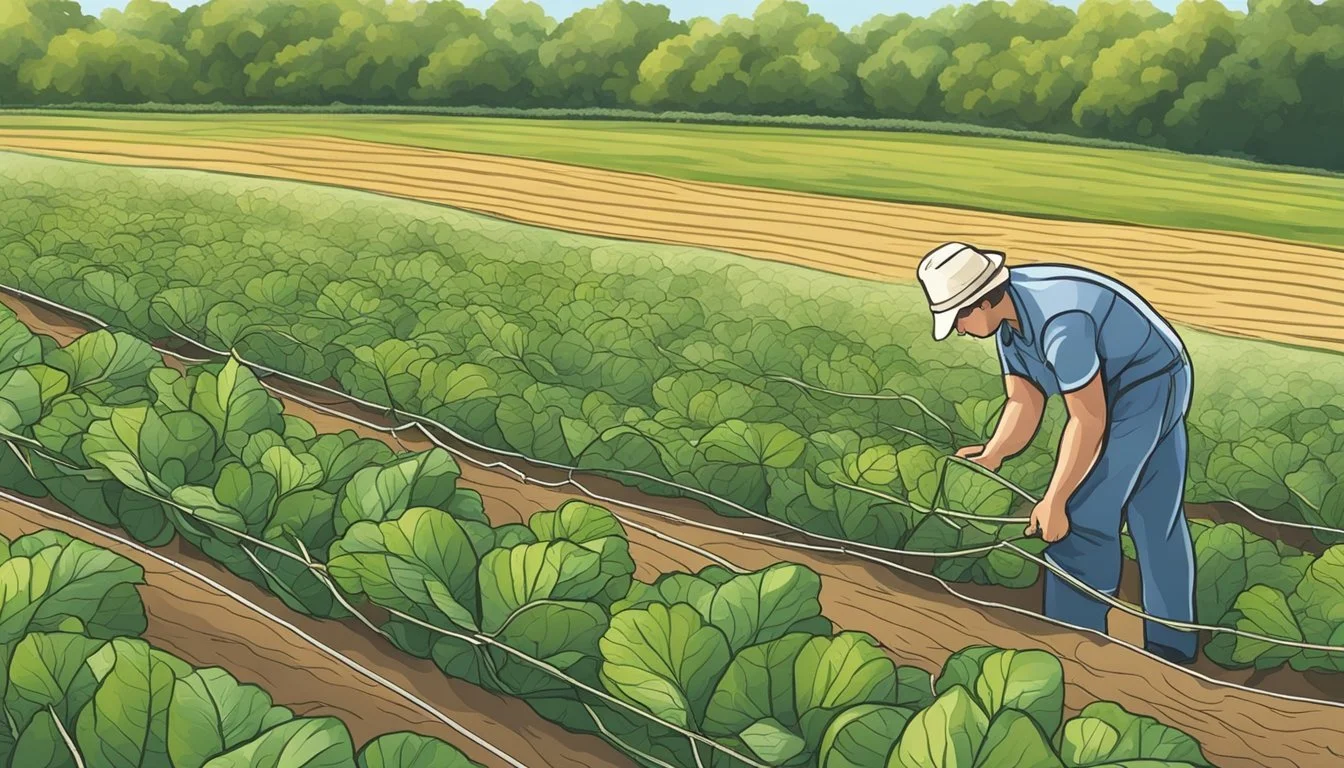Protecting Crops from Variegated Cutworm
Effective Management Strategies
Variegated cutworms pose a significant threat to a variety of crops, including corn and beans, due to their feeding habits which can severely damage both foliage and fruit. Recognizable by their brownish-grey coloration and distinctive diamond-shaped marks along their back, these caterpillars have a tendency to chew shallow or deep holes into the produce, which can lead to substantial yield losses. Effective management of variegated cutworm relies on a combination of timely scouting, identification, and implementation of control strategies to minimize the impact on crops.
Agriculturists seeking to protect their crops from the ravages of cutworms must be vigilant in monitoring, as early detection is key to preventing widespread infestation. The lifecycle of the cutworm involves moths laying eggs primarily on grasses, which points to the importance of maintaining clean field edges to reduce potential breeding grounds. Intervention methods, such as making plant collars to shield stems, may serve as a preventive measure, especially after transplanting when plants are most vulnerable.
Understanding the patterns and behaviors of variegated cutworms, including their common habit of curling up into a C-shape when disturbed, equips farmers with the knowledge to identify the presence of these pests. With proper management techniques in place, such as detailed scouting and monitoring, the risk of cutworm damage can be effectively managed, safeguarding the productivity and profitability of the crops.
Identification of Variegated Cutworm
Identifying the variegated cutworm is essential for protecting crops effectively. This section covers the main physical features and the life cycle stages of this pest.
Physical Characteristics
The variegated cutworm (Peridroma saucia) can be recognized by its brownish-gray color. Caterpillars reach up to 2 inches long and have distinct diamond-shaped marks along their back with lighter lines along the sides. They possess four pairs of prolegs, which are leg-like appendages located in the middle of the abdomen. These physical traits are crucial indicators for early identification and management of this pest.
Color: Brownish-gray
Distinctive Markings: Diamond-shaped marks on back
Legs: Prolegs on segments 3 to 6
Size: Up to 2 inches long
Life Cycle of Variegated Cutworm
The life cycle of the variegated cutworm includes several stages: eggs, larvae, pupae, and adult moths. Moths migrate from the south, arriving between March and June, and lay eggs primarily on grasses. After hatching, the larvae feed on leaves and fruits, often creating shallow or deep holes. The larvae eventually evolve into pupae, and then into adult moths which can have wingspans up to 1 1/2 inches across. Understanding this cycle helps in predicting and controlling infestations.
Egg Stage: Laid mostly on grasses
Larval Stage: Feeding occurs on leaves and fruits
Pupal Stage: Transition stage before adulthood
Moth Stage: Gray-brown moths, wingspan up to 1 1/2 inches
Monitoring Variegated Cutworm Population
Effective monitoring of variegated cutworm populations is critical to protect crops and minimize damage. Accurate detection and assessment of cutworm presence in the field can guide timely interventions against these pests.
Scouting Methods
Scouting involves regularly walking through the field, inspecting plants, and examining the soil for signs of cutworm activity. It is an essential tool for early detection. Scouts should look for missing plants or cut stems near the plant base, which are indicative of cutworm presence. Additionally, scouts should check the top inch of soil where cutworms hide during the day. A key sign of black cutworms, a common type, is irregular holes in plant leaves. Regular field assessments support effective monitoring by building an accurate picture of the cutworm lifecycle stage and population density.
Pheromone Traps
Pheromone traps are useful for predicting cutworm infestations by attracting and capturing adult moths. The placement of these traps around the perimeter of the field or in areas with a history of cutworm problems aids in the early identification of a potential outbreak. As adults are caught, farmers can estimate the size of the upcoming generation and prepare accordingly. It is crucial to use species-specific pheromone lures to target variegated cutworms accurately.
Environmental Indicators
Monitoring environmental conditions is also an essential method for predicting cutworm activity. Significant rainfall followed by warm temperatures can increase cutworm emergence from the soil. Farmers should pay attention to these environmental cues as they can signal the need for increased vigilance in scouting and the use of pheromone traps. Variables like soil moisture and temperature are key environmental indicators influencing cutworm development and movement within the field.
Understanding Cutworm Damage
In considering the threat of variegated cutworms, one must recognize the pronounced damage they cause to a plethora of crops. They are notorious for their potential to devastate seedlings and mature plants alike by attacking the stem and foliage.
Common Signs of Infestation
Detecting an infestation early hinges on recognizing:
Seedlings severed near the soil surface: This often suggests nocturnal feasting by cutworms.
Irregular holes in leaves and fruit: Such damage patterns are indicative of cutworm activity.
Vigilance is crucial, as cutworms tend to be active at night, and evidence of their presence is typically encountered during daylight hours.
Impacted Plants and Crops
Cutworms do not discriminate widely; a variety of vegetables and fruits are at risk. They frequently target:
Vegetables: Carrots, beets, and a broad range of others face the threat of cutworm attack.
Grasses and crops: Corn and beans are also commonly impacted by cutworm activities.
Each plant affected can suffer from cutworms' voracious appetites as they feed at or above the soil level, causing potentially significant losses.
Preventive Strategies
Effective management of Variegated cutworms in agricultural settings encompasses a combination of cultural, biological, and chemical measures. These practices aim to prevent infestations before they can cause significant damage to crops.
Cultural Control
Cultural control methods involve altering the environment to make it less conducive to cutworm populations. Tillage can disrupt the cutworm life cycle by exposing larvae and pupae to desiccating conditions and predators. This makes it difficult for them to overwinter successfully. Integrating cover crops and maintaining weed-free fields are also vital, as they can reduce the potential habitat and food sources for cutworms.
Tillage: Expose soil to reduce overwintering and interrupt the life cycle.
Weed Management: Maintain a weed-free environment to reduce egg-laying sites and food sources.
Cover Crops: Plant cover crops that do not support cutworm survival, breaking their life cycle.
Biological Control
Natural predators and diseases can be utilized for biological control of variegated cutworms. Beneficial organisms, such as predatory beetles, parasitic wasps, and birds, feed on the larvae and eggs of cutworms. The application of Bacillus thuringiensis (Bt), a bacterial insecticide, is particularly effective against young larvae, serving as a safe and selective insecticide.
Natural Predators: Encourage predatory insects and birds in the field to feed on cutworms.
Bacillus thuringiensis: Use Bt formulations to target early instar larvae while minimizing impact on non-target species.
Chemical Control
When cultural and biological controls are insufficient, chemical interventions may be necessary. Insecticides like methomyl and carbaryl have been proven effective against cutworms, but should be used judiciously to mitigate the risks of resistance and non-target effects.
Insecticides: Apply as necessary, following label instructions and resistance management best practices.
Spot Treatments: Consider localized applications where infestations are dense to reduce overall pesticide use.
Carefully timed and targeted applications combined with integrated pest management can significantly reduce the variegated cutworm threat to crops.
Integrated Pest Management (IPM) Approach
Integrated Pest Management, or IPM, is a science-based, decision-making process that identifies and reduces risks from pests and pest management related strategies. It coordinates the use of pest biology, environmental information, and available technology to prevent unacceptable levels of pest damage by the most economical means, while posing the least possible risk to people, property, and the environment.
Treatment Decisions
To effectively protect crops from the variegated cutworm, treatment decisions should be made based on thorough monitoring and identification. This information directs the choice of management methods, ensuring they are utilized at optimal times for effectiveness. Pesticides may be used, but with careful selection and timing to minimize negative impacts on the environment and to mitigate the development of resistance. Use of IRAC (Insecticide Resistance Action Committee) group number is pivotal in resistance management to rotate modes of action of pesticides effectively.
IPM Value
The value of IPM lies in its balanced approach, incorporating multiple strategies for management of the variegated cutworm. Strategies include cultural practices, mechanical controls, biological controls, and chemical methods. IPM also involves the education of famers and agricultural workers in IPM principles, fostering an understanding of the ecological relationships between pest and crop. This comprehensive approach not only manages the current pest problems efficiently but also contributes to sustainable agriculture with long-term pest resistance management.
Cultural Practices for Protection
Effective management of Variegated cutworms in agricultural settings involves implementing cultural practices that reduce the pests' habitat and interrupt their life cycle. These practices focus on making the environment less conducive for cutworm development and preserving the health of the crop.
Crop Rotation
Crop rotation is a fundamental strategy in disrupting the lifecycle of cutworms. By alternating the crops planted in a field each year, farmers can effectively reduce cutworm populations. For instance, rotating vegetables with non-host crops like grasses can prevent cutworms from having a consistent food source. This practice assists in lowering pest numbers over time and diminishes the likelihood of severe infestations.
Tillage and Field Sanitation
Tillage serves a crucial role by directly destroying cutworm larvae and exposing them to predators. Deep plowing of fields eliminates weeds and remnants of previous crops, which may harbor overwintering stages of cutworms. Meanwhile, effective field sanitation involves removing plant debris and weeds that can provide shelter for cutworms around the soil line. Regularly cleaning up the field can significantly reduce the population of cutworms.
Use of Resistant Varieties
When available, planting resistant varieties of crops can greatly impede cutworm damage. These plants have natural defenses that make them less attractive or more tolerant to cutworm feeding. Cultivars that exhibit rapid early growth may better withstand cutworm activity near the soil line, as they can outgrow minor damage and reduce overall yield loss. Hence, the selection of such varieties is an invaluable component of cultural control practices.
By enhancing cultural control methods like crop rotation, diligent tillage, and the use of resistant crop varieties, farmers can protect their vegetables from the detrimental impact of Variegated cutworms effectively.
Biological Tactics
Biological tactics in crop protection leverage nature's own mechanisms to control the variegated cutworm, a pest that can severely impact a range of host plants. Strategic use of natural predators and specific microbial insecticides provides an effective line of defense.
Natural Predators and Parasitoids
Several predators naturally regulate cutworm populations. Birds are known to feed on the larvae, while ground beetles and parasitoidal wasps target the larval stage, reducing their numbers. By maintaining a weedy buffer or cover crops around fields, farmers can attract these beneficial organisms which lay their eggs on or near the cutworm larvae. The College of Agricultural Sciences provides insights on creating an environment conducive to these natural enemies.
Bacillus Thuringiensis Application
A Bacillus thuringiensis (Bt) application serves as a biological control by exploiting the bacterium's larvicidal properties. The crystalline proteins produced by Bt specifically target and disrupt the gut of cutworm larvae upon ingestion. It is imperative to apply Bt correctly; timing and concentration play crucial roles in its efficacy. The University of Idaho details appropriate application strategies. As a biological pesticide, Bt is safe for many non-target organisms, aligning with integrated pest management protocols.
Chemical Management
Effective chemical management is crucial for protecting crops from the variegated cutworm. Choosing the correct insecticide and applying it at the optimal time can significantly reduce crop damage.
Insecticide Options
For controlling variegated cutworms, a range of insecticides is available. These include methoxyfenozide and spinosad, which are known for their efficacy against lepidopteran larvae. It's important to consider the preharvest interval and restricted entry interval when selecting a chemical for application. Insecticides must be approved for use on the specific crop and against cutworms to ensure legal and safe usage.
Methoxyfenozide: An insect growth regulator that disrupts the molting process in cutworm larvae.
Spinosad: A natural substance made by a soil bacterium that can be toxic to insects.
Application Timing and Methods
Application timing is essential for the chemical management of the granulate cutworm. Treatment should coincide with the emergence of young larvae, which cause the most damage. Following the manufacturer's guidelines for application methods can lead to more effective control. Meanwhile, treatment decisions should be based on careful monitoring of cutworm populations and thresholds to optimize the timing of insecticide applications.
Foliar Sprays: These can be applied when larvae presence is detected.
Granular Applications: These target larvae near or in the soil and are best applied in the evening when cutworms are most active.
Environmental Considerations
Protecting crops from the Variegated cutworm necessitates a thorough understanding of the pest's management strategies and their consequential environmental impact. The balance lies in effectively mitigating damage to crops while preserving ecological integrity and public health.
Impact on Non-target Species
When employing pest control measures against Variegated cutworms, non-target species can inadvertently be affected. Biological control agents, for instance, introduce predators that specifically target cutworms, but could potentially disrupt other insect populations if not carefully managed. Chemical controls might have a wider impact, harming beneficial insects like pollinators if not selected and applied judiciously. It is crucial to select pest management options that minimize adverse effects on non-target species to maintain biodiversity and ecosystem function.
Water Quality and Safety
The use of pesticides to combat Variegated cutworms must consider the ramifications for water quality. Pesticides can leach into groundwater or run off into surface water, posing risks to aquatic life and potentially contaminating drinking water supplies. To safeguard water quality and safety, following proper application methods and timings is essential. Resistance management also plays a role, as overuse of pesticides can lead to resistant cutworm populations, necessitating higher doses and increasing environmental risks. Implement control measures that align with environmental safety standards and integrate practices that reduce the likelihood of resistance development.
Economic Thresholds and Risk Factors
Understanding the economic thresholds and risk factors for variegated cutworm is essential in protecting crops like corn, beans, cabbage, and tomatoes. These measures help determine when intervention is cost-effective and necessary to prevent significant damage to seedlings and mature plants.
Determining Economic Losses
Economic thresholds for pests like the variegated cutworm are crucial in making informed decisions about pest management. They indicate the density at which caterpillars or larvae feed on crops to the point where the cost of damage exceeds the expense of control measures. For crops such as corn and tomatoes, intervention is generally recommended when the presence of cutworm larvae reaches a critical number that threatens to reduce the yield to a degree that surpasses the cost of pest control activities. It's important to monitor for larvae feed activity around seedlings and transplants, as early-stage plants can be highly susceptible to cutworm damage, impacting long-term harvest potential.
Risk Assessment for Crop-Specific Cultivation
The risk of variegated cutworm damage varies based on several factors, such as crop type, previous crop residue, tillage practices, and presence of weeds. Fields with heavier residues from previous crops, especially those that are poorly drained or weedy, provide an ideal environment for cutworms to thrive. Beans and cabbage, which may require different cultural practices, can have varied risk levels. Actively managing field edges, cleaning up crop residue, and monitoring for moth flights help in assessing the risk to the specific cultivation practices of a given crop. Proactive risk assessments enable timely management strategies to protect vital crops from economic losses due to variegated cutworm infestations.
Specific Crop Guidelines
Effectively protecting crops from the variegated cutworm is vital for securing yields. These guidelines focus on specific measures tailored to various crops susceptible to cutworm damage.
Protective Measures for Vegetable Crops
For safeguarding vegetables like tomatoes, carrots, asparagus, broccoli, cauliflower, lettuce, peas, peppers, potatoes, and spinach, farmers can employ several strategies. It is essential to maintain a clean field by removing plant debris and weeds, which serve as habitats for cutworms. Utilize floating row covers to physically prevent moth access and egg-laying. Moreover, crop rotation discourages the pest's lifecycle continuity.
Cabbage, Broccoli, and Cauliflower: Till the soil before planting to disrupt the cutworm habitat and inspect transplants for larvae before planting.
Carrots and Spinach: Apply appropriate insecticides if scouting reveals larvae that exceed economic thresholds.
Tomatoes and Peppers: Ensure proper irrigation and fertilization to promote rapid plant growth, outpacing the damage potential of cutworms.
Management in Field Crops
In field crops such as corn, beans, and sweet corn, monitoring and timely intervention are crucial. Scout field edges and grassy areas, as these are common places where moths lay their eggs. Crop scouting should begin early in the season to detect and manage larvae before they can cause significant damage.
Corn and Sweet Corn: Look for cutworms during the early vegetative stages. Treatment thresholds are reached when 3% of plants are damaged and live cutworms are present.
Beans: Delay planting until soil is warm to encourage rapid crop emergence, which can help beans outgrow cutworm damage.
Implementing these measures requires a proactive approach to crop management, focusing on early detection and targeted interventions to protect against the variegated cutworm.
Record Keeping and Future Outlook
Accurate record keeping and a forward-looking perspective are crucial in the ongoing battle against the Variegated cutworm in agricultural settings. These practices ensure informed decision-making for current and future pest management.
Documentation of Infestations
Farmers should meticulously document cutworm infestations, noting the following:
Date of detection
Extent and location within the field
Crops affected and the degree of damage
Control methods used and their effectiveness
This data forms a comprehensive historical record that aids in recognizing patterns and predicting future outbreaks. Data should be stored in an easily accessible format, making it possible for quick retrieval and analysis.
Long-Term Cutworm Management
Proactive long-term management is rooted in understanding cutworm life cycles and monitoring fields. Actions include:
Implementing crop rotations to discourage cutworm presence
Utilizing resistant plant varieties
Timing planting schedules to avoid peak cutworm activity
Monitoring represents a key aspect of management, involving regular field inspections and employing pheromone traps to gauge cutworm populations. These measures, if consistently applied and adjusted based on field records, shall contribute to a positive future outlook in the management of the Variegated cutworm.
Frequently Asked Questions
This section answers key concerns regarding the prevention and control of variegated cutworm infestations in agricultural settings.
What are the most effective insecticides for managing cutworm infestations in crops?
The efficacy of insecticides can vary; however, products containing lambda-cyhalothrin, chlorantraniliprole, and spinosad are among those commonly recommended for cutworm control. Always follow the label instructions and consider the impact on non-target organisms when applying these chemicals.
How can farmers implement natural methods to deter variegated cutworms from their crops?
Farmers can utilize crop rotation, tillage to reduce larvae population in soil, and biological control measures. Practices like creating barriers around seedlings can physically prevent cutworms from reaching vulnerable plants.
What biological control strategies exist for reducing cutworm populations?
Biological control may include releasing natural enemies like parasitoid wasps, or applying bacterial insecticides like Bacillus thuringiensis. These methods target cutworm larvae while having minimal impact on other beneficial organisms.
What are common indicators of cutworm damage on agricultural plants?
Indicators of cutworm presence are seen as chewed or missing seedlings, irregular holes in stems, and wilting plants. Nocturnal inspections can reveal larvae feeding on plants.
What predators naturally regulate cutworm populations, and how can they be attracted to farmlands?
Birds, ground beetles, and parasitic wasps are natural predators of cutworms. Farmers can attract these beneficial species by planting habitat borders with flowers and providing nesting sites.
Could you explain the life cycle of cutworms and its implications for pest control in agriculture?
Cutworms overwinter as pupae and moths emerge in spring to lay eggs on host plants. Understanding the life cycle allows farmers to time interventions, such as tilling at pupal stages or applying insecticides when larvae are most vulnerable.

